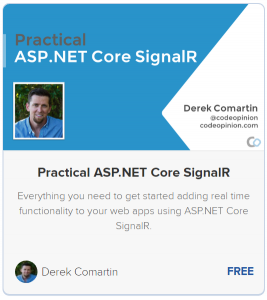Sponsor: Do you build complex software systems? See how NServiceBus makes it easier to design, build, and manage software systems that use message queues to achieve loose coupling. Get started for free.
 I’ve been working on a course! Practical ASP.NET Core SignalR. I’m going to be posting all of the sections as blog posts here on CodeOpinion.com, my YouTube Channel, and free on Teachable.
This course is a complete step-by-setup guide on how to build real-time web applications using ASP.NET Core SignalR. By the end of this course, you’ll be able to build real-world, scalable, production applications using the tools and techniques provided in this course.
I’ve been working on a course! Practical ASP.NET Core SignalR. I’m going to be posting all of the sections as blog posts here on CodeOpinion.com, my YouTube Channel, and free on Teachable.
This course is a complete step-by-setup guide on how to build real-time web applications using ASP.NET Core SignalR. By the end of this course, you’ll be able to build real-world, scalable, production applications using the tools and techniques provided in this course.
What You’ll Learn
The purpose of this course is to give you an overview with code samples of many of the core aspects of creating a web application that can leverage SignalR to add real-time capabilities. We will cover what ASP.NET Core SignalR is, what problems it solves and how it solves it. I will go over the basics of the intial setup of SIgnalR in your ASP.NET Core web app. We will setup a JavaScript client using vanilla javascript and the SignalR javascript client library. Dive a bit deeper into some server concepts for handling authorization as well as accessing SignalR from other parts of your application such as Controllers or Services. Lastly, I’ll go over a couple of scaling options with Redis and the Azure SignalR Service.Required Knowledge
There are some requirements if you want to follow along with the course. Existing knowledge or at least being familiar with in C#, ASP.NET Core and JavaScript are required. If you aren’t that familiar yet with ASP.NET Core, then some of the setup might be a bit confusing. Plain old JavaScript is used in all the code samples without any additional frameworks or libraries. This makes things a bit more cumbersome but is still straightforward.Environment / Setup
I’ll be using Microsoft Visual Studio Code throughout the course. If you want to follow along, you can use whatever editor or IDE you choose. Nothing in the tutorials are specific to an editor or IDE. If you prefer to use Visual Studio or JetBrains rider, no problem. If you are developing on a Mac or Linux, also not a problem. Just make sure you download the correct .NET Core SDK. What you’ll need:- Windows, Linux, or MacOS
- .NET Core 2.1
- Visual Studio Code (optional)
Get The Course!
You’ve got several options:- Check out my Practical ASP.NET Core SignalR playlist on my CodeOpinion YouTube channel.
- Access the full course now by enrolling for free on Teachable.
- Follow along with the blog post series here on CodeOpinion.com